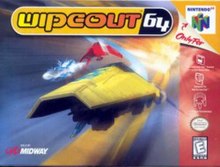
F-Zero X is a 1998 futuristic racing video game for the Nintendo 64 console, developed and published by Nintendo. It is a sequel to the original F-Zero (1990), and is the first F-Zero installment with 3D graphics. The game has a steep learning curve and its gameplay experience is similar to that of the original. An Expansion Kit, including a track and vehicle editor, was released in Japan in 2000.
Wipeout is a series of futuristic anti-gravity racing video games created by Psygnosis. Sony Interactive Entertainment owns the series and publishes most of the games.

Cruis'n USA is a racing video game developed by TV Games Inc. and published by Nintendo. It was first released in arcades in 1994 by Midway Games, with a port to the Nintendo 64 developed by Leland Interactive Media released in 1996. It is the first game in the Cruis'n series and features races set in locations across the Continental United States.

Cruis'n Exotica is a 1999 racing game developed and published by Midway Games for arcades. The game is a sequel to Cruis'n World and is the third entry in Nintendo's Cruis'n series. A port to the Nintendo 64 developed by Gratuitous Games was released in 2000, along with a Game Boy Color version developed by Crawfish Interactive.

1080° Snowboarding is a snowboarding video game developed and published by Nintendo for the Nintendo 64 in 1998. In the game, players control one of five snowboarders from a third-person perspective, using a combination of buttons to jump and perform tricks across eight levels.

Wipeout 2097 is a 1996 racing video game developed and published by Psygnosis for the PlayStation. It is the second installment of the Wipeout series and a sequel to the original game, released the previous year. It was ported the following year to Microsoft Windows and the Sega Saturn, and later also to Amiga and Macintosh.

Wipeout Fusion is a 2002 racing video game developed by Studio Liverpool and published by Sony Computer Entertainment for the PlayStation 2. The fifth instalment in the Wipeout series, following Wipeout 3 (1999), it was the first as well as the only original Wipeout title for PlayStation 2, with a port of Wipeout Pulse in 2009 being the only other Wipeout released on the platform. The game takes place in 2160 and revolves around players competing in the F9000 anti-gravity racing league. Wipeout Fusion received positive reviews upon release, with particular praise being directed at its techno soundtrack, but its graphics and track design received mixed responses from critics.

Turok 2: Seeds of Evil is a first-person shooter video game developed by Iguana Entertainment and published by Acclaim Entertainment. It was released for the Nintendo 64 console in 1998 and ported to Microsoft Windows computers in 1999. Seeds of Evil is the second game in the Turok video game series and a sequel to Turok: Dinosaur Hunter. The game follows the story of a Turok and his efforts to stop a powerful alien entity from escaping the confines of his Lightship. A different game set in the same fictional universe, also titled Turok 2: Seeds of Evil, was released for the Game Boy Color alongside the Nintendo 64 game.

Tetrisphere is a puzzle video game developed by H2O Entertainment and published by Nintendo for the Nintendo 64. It was released in North America on August 11, 1997, and in PAL regions in February 1998. The game, originally titled Phear, was initially intended for release on the Atari Jaguar in early 1995 but was reworked into a Tetris game for the N64 after Nintendo, a licensee for The Tetris Company, obtained the publishing rights.
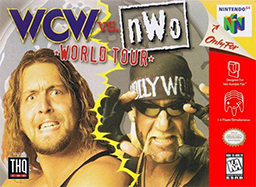
WCW vs. nWo: World Tour is a professional wrestling video game released in 1997 for the Nintendo 64 game console. Released at the peak of World Championship Wrestling's (WCW) dominance in the Monday Night War, World Tour was THQ's first foray into the N64 wrestling scene and is a semi-sequel to the lesser known WCW vs. the World for the PlayStation. It is the second best-selling wrestling game for the N64 console.

Buck Bumble is a 1998 third-person shooter game for the Nintendo 64 developed by British video game company Argonaut Software and released by Ubi Soft. A special Buck Bumble rumble pack was packaged with the U.K. version.
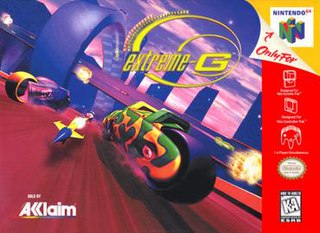
Extreme-G is a futuristic racing video game developed by Probe Entertainment and published by Acclaim Entertainment, featuring an original trance soundtrack. It was released for the Nintendo 64 in 1997, with a Japan release on May 29, 1998. Despite the competitive landscape of Nintendo 64 racing games, Extreme-G received moderately positive reviews and achieved commercial success. A sequel, Extreme-G 2, was launched in 1998, followed by two additional titles: Extreme-G 3 (2001) and XGRA: Extreme-G Racing Association (2003). In 2024, the game was re-released through the Nintendo Switch Online + Expansion Pack by Throwback Entertainment, which acquired the rights to the game in 2006.
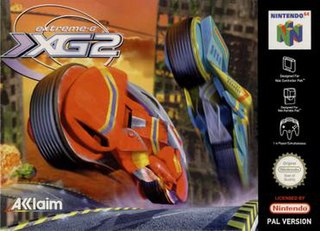
Extreme-G 2, also known as Extreme G: XG2, is a racing video game developed by Probe Entertainment and published by Acclaim Entertainment for the Nintendo 64 and Microsoft Windows. It serves as the sequel to Extreme-G and is followed by Extreme-G 3.

Wipeout 3 is a 1999 racing video game developed by Psygnosis and published by Sony Computer Entertainment for the PlayStation. It is the fourth game and third main instalment in the Wipeout series, following Wipeout 64 (1998), and the third on PlayStation following Wipeout 2097 (1996). It is the first game in the series to be released on neither a Sega or Nintendo console nor personal computers. Players control anti-gravity ships and use weapons to force other contenders out of the race.

Wipeout is a 1995 racing video game developed and published by Psygnosis for the PlayStation. The first instalment in the Wipeout series, it was a launch title for the PlayStation in Europe. It was ported to DOS, followed by Sega Saturn the next year. Psygnosis' parent company, Sony Computer Entertainment, re-released the game for the PlayStation 3 and PlayStation Portable via the PlayStation Network in 2007.

South Park is a first-person shooter video game based on the American animated sitcom of the same name. The game was developed by Iguana Entertainment, using a modified version of the engine used in the Acclaim Entertainment-published Turok 2: Seeds of Evil; both games shared the same publisher and were released for the Nintendo 64 in 1998 in North America, and for Microsoft Windows in 1999. South Park was released in Europe and ported to the PlayStation in the latter year to coincide with the film South Park: Bigger, Longer & Uncut.

Aero Fighters Assault is an arcade-style combat flight simulator developed by Paradigm Entertainment and published by Vic Tokai and Video System for the Nintendo 64 in 1997.

AeroGauge is a hovercraft racing game designed for the Nintendo 64 game console and released in 1998. The game was developed by Locomotive and published by ASCII. It is conceptually similar to Psygnosis' Wipeout or Acclaim's Extreme-G. The main difference is that the vehicles in the game fly instead of hovering. AeroGauge garnered mediocre reviews, with criticism directed at its routine concept, excessive pop up, lack of weapons and power-ups, and overly high difficulty.

Destruction Derby 64 is a vehicular combat racing video game developed by Looking Glass Studios and published by THQ, under license from Psygnosis. It is the third installment in the Destruction Derby series, released on 30 September 1999 in North America and 12 October 1999 in Europe for the Nintendo 64.
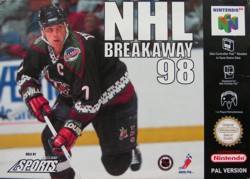
NHL Breakaway 98 is a 1997 ice hockey video game for the PlayStation and Nintendo 64. It was the first hockey game to come from Acclaim Entertainment and the first game released under the publisher's new Acclaim Sports label. The game met with divisive reviews upon its release for the PlayStation, though the game's management mode and its system of using points to improve aspects of a team received widespread praise, but reviews for the later Nintendo 64 version were more consistently favorable. It was followed by a sequel, NHL Breakaway 99, released the following year.
